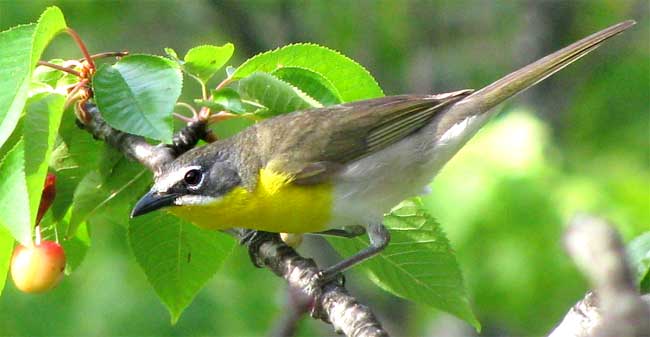Excerpts from Jim Conrad's
Naturalist Newsletter

from the the June 21, 2009 Newsletter, issued from the Siskiyou Mountains west of Grants Pass, Oregon:
CHERRY LOVING CHAT
There's another bird species you don't think of as a fruit eater who's similarly passionate about our cherries nonetheless. You can see who I mean above.
That's a Yellow-breasted Chat, ICTERIA VIRENS. Chats are very atypical members of the big Wood Warbler Family. For one thing, they're by far the largest of all warblers. Also, their thick, bent bills are very unlike those of other warblers, whose very slender beaks help them with their pecking at insects. To my mind, however, the most unwarbler thing about chats is their singing. My field guide describes the Yellow-breasted Chat's song as "an amazing alternation of caws, whistles, grunts and rattles, frequently given in flight and even at night." This week often in the deep of night I've heard the chat's racket. You can hear it, too, by clicking on the orange "Listen" icon at the upper, left corner of the page at http://www.enature.com/fieldguides/detail.asp?recNum=BD0370.
Here the chats' calls strike me as a little different from those back East. Certain grunts and whistles are lacking while others are new for me. My impression is that the Eastern chats' calls are more emphatic, more mechanical-sounding than ours though ours have those features as well. Our chats' calls seem a little more laid-back that the East's.
Yellow-breasted Chats fairly commonly show up in thickets all across the US, except in some of the northeastern states. Here they hang around our very luxuriant blackberry thickets.
Yellow-breasted Chats are unmistakable in the field with their bright yellow chests, olive-green upperparts, and the conspicuous white spectacles